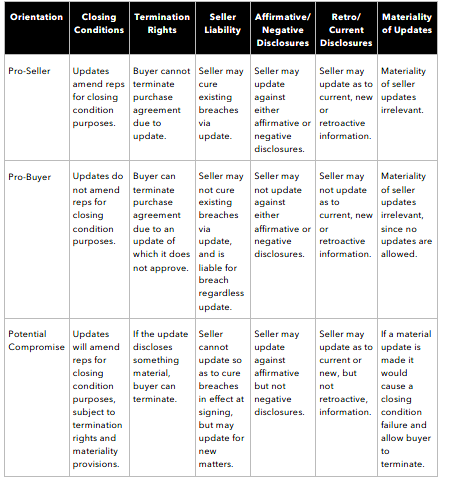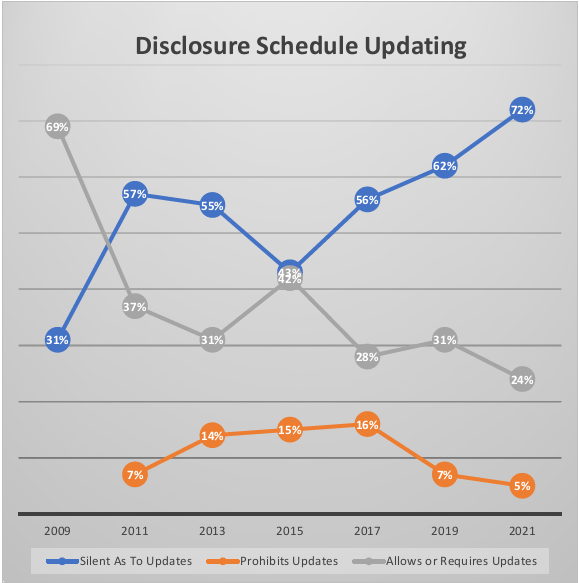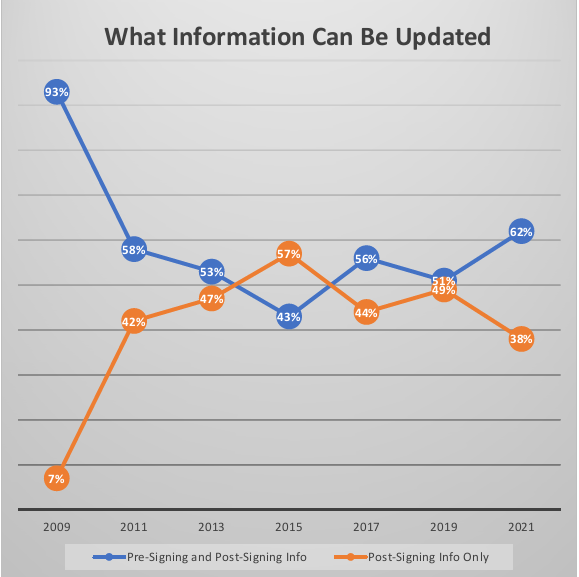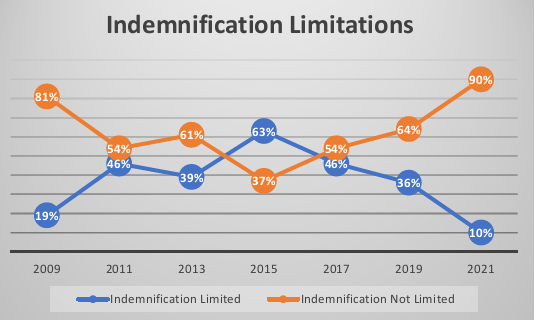Goulston & Storrs M&A attorney Dan Avery is a nationally recognized expert on M&A deal point trends. In partnership with Bloomberg Law, Dan has developed a series of 25 articles looking at these trends, on a topic-by-topic basis, providing practical insight into where these trends are heading, and the relevant implications for M&A deal professionals.
Market Trends: What You Need to Know
Over the past several years:
- An express right, or obligation, of sellers to update disclosure schedules between signing and closing is becoming less common; instead, more M&A agreements are staying silent on the point.
- Where disclosure schedule updating is contemplated, practice is somewhat divided as to whether the updating can include pre-signing information, and not just post-signing information. And increasingly, a buyer's indemnification rights are not limited or impacted by any required or permitted new disclosures.
- As a related point, one-half to to three-quarters of reported deals include an express obligation on the part of the seller to disclose breaches of the M&A agreement prior to closing.
Introduction
Disclosure schedules are a common component of an M&A purchase agreement (whether a stock purchase agreement, asset purchase agreement, or merger agreement). Disclosure schedules provide fact-specific disclosures or exceptions to specific statements relating to the seller's representations and warranties. As such, they are an integral part of, and directly impact the scope of a seller's responsibility for, those representations and warranties.
For a seller about to sign an M&A purchase agreement, the question is prospective: how should the parties deal with pre-closing developments through disclosure schedule updates? Sellers may want maximum flexibility to disclose new matters, through post-signing disclosure schedule updates, as those evolve and occur prior to closing. Buyers will want appropriate limitations, controls and/or other rights—whether as to termination, indemnification or otherwise—relating to disclosure schedule updates, depending on the type, materiality and timing of the new disclosures, among other factors.
The Covid-19 virus underscored this aspect of M&A practice. Buyers and rep and warranty insurers are focusing more aspects of their due diligence on virus-related matters. Transaction parties negotiated expanded or new representations to address the effect of Covid-19 on the target business, as well as the policies and protocols for dealing with those effects. And, at the same time, M&A sellers sought to disclose more Covid-19 matters and consequences—past, present or future—to buyers, on their disclosure schedules. For transactions subject to a signed M&A purchase agreement but which have not yet closed, sellers look to their purchase agreements to see how the topic of disclosure schedule updating is addressed.
This article looks at disclosure schedule updating options most commonly negotiated in M&A purchase agreements, as well as related market trends for private company M&A transactions. These trends are reflected in the American Bar Association's Private Target Mergers and Acquisitions Deal Points Studies (the ABA studies), which cover U.S. M&A transactions involving privately held targets.
Discussion
Unless the purchase agreement contemplates a simultaneous signing and closing, there will be some period of time between signing and closing. The period of time between signing and closing can run from days to months, depending on the conditions that must be met prior to the closing.
Because the disclosure schedules are typically attached to and part of the purchase agreement, the disclosures usually are made as of the signing date (or specified dates prior to closing). At the same time, a buyer will normally want full and complete disclosures as of the closing date, whether as a condition to closing or as a matter of due diligence. Accordingly, buyers and sellers need to agree on whether a seller should be allowed—or be required—to update disclosure schedules or otherwise notify the buyer of relevant developments occurring prior to closing, and what the “ground rules” for those updates and/or notifications should be.
In the interim period between signing and closing, the seller will continue to enter into contracts, hire and fire employees, address liabilities and claims as they arise, and otherwise continue operations of the target business. A seller's disclosure schedules provided at the signing of the purchase agreement would not, therefore—absent some type of updating mechanism—reflect facts or information coming to light after signing and prior to closing. This can be problematic, particularly if (and as is often the case) a seller's representations and warranties are made to the buyer as of the signing of the purchase agreement and as of the closing.
Affirmative v. Negative Disclosures
Disclosures made in disclosure schedules generally fall within two different categories:
- “Affirmative” Disclosures. These are disclosures in which seller must affirmatively disclose certain information as required under the corresponding representations and warranties. It is typical for a purchase agreement to include seller representations and warranties requiring that the disclosure schedule list certain material contracts, employees and employee benefit plans, current litigation, etc.
- “Negative” Disclosures. These are disclosures “against,” or as exceptions or qualifiers to, the seller's representations and warranties. As an example, a purchase agreement may include a representation by the seller that the target business has complied with all applicable laws, except as set forth on the disclosure schedules.
Primary Implications of Disclosure Schedule Updating
Generally, three different, but related, aspects of the purchase agreement (and the resulting relationship between seller and buyer) impact the seller's ability to update the disclosure schedules.
- Closing Conditions. Most purchase agreements require, as a condition to the buyer's obligation to close the transaction, that the seller's representations and warranties continue to be true and correct (or materially true and correct) as of the closing. If the seller is allowed unilaterally to update the disclosure schedules, and therefore “amend” its representations and warranties, this closing condition could be of reduced value to the buyer.
- Termination Rights. If the seller is allowed to update disclosure schedules, should the buyer, if nothing else, have the right to terminate the purchase agreement?
- Liability for Breach. Similarly, even if the seller is permitted to provide disclosure schedule updates, should the updates absolve the seller of responsibility under that representation or warranty? Put another way, should a seller be able to cure a breach of a representation or warranty existing at the time of signing by amending the disclosure schedules and therefore the seller's representations and warranties?
Other Relevant Factors
As noted above, seller disclosures in the disclosure schedules generally can be characterized as either affirmative disclosures—disclosures of contracts or other items affirmative called out in the relevant representation—or negative disclosures—disclosures that provide exceptions to affirmative statements within the relevant representations. This distinction can be important as buyers may be more amenable to disclosure schedule updates with respect to affirmative, rather than negative, disclosures. For example, if a seller enters into a new material contract prior to closing, and that contract would have been disclosed if it had been in place at the time of signing, it is difficult to argue against allowing the seller to amend the disclosure schedules to reflect that new contract. This is especially true if entering into the contract was in compliance with the seller's covenants regarding operation of the target business prior to closing.
Similarly, and related to the issues of termination rights and seller liability, whether or not an update relates to new information or facts, as opposed to those existing at the time of signing, can be relevant. A seller may have a more compelling case to update disclosure schedules for events occurring after the signing than to add facts which were in place or occurring at or prior to signing, but were not disclosed at that time (whether by human error, lack of knowledge, etc.).
Finally, the materiality of the new disclosure can be relevant for determining the effect of disclosure schedule updating. Logic suggests that a buyer should have more input and rights with respect to a matter newly disclosed, based on the materiality of that matter, whether materiality is measured in terms of financial implications or business operations.
Alternatives for Disclosure Schedule Updating Provisions
The matrix below summarizes the typical pro-seller and pro-buyer approaches with respect to the updating factors and issues described above, as well as common compromise positions:


The ABA Studies
Every other year since 2005, the ABA has released its Private Target Mergers and Acquisitions Deal Points Studies. The ABA studies examine purchase agreements of publicly available transactions involving private companies. These transactions range in size but are generally considered as within the “middle market” for M&A transactions; the transaction values of the 123 deals within the 2021 study ranged from $30 to $750 million.
The most recent ABA studies have looked at whether the reported deals: allowed or required disclosure schedule updates; prohibited such updates; or were silent on the topic. These results are set forth below.
GRAPHIC—Source: ABA Private Target Mergers and Acquisitions Deal Points Studies


As a practical matter, if an agreement is silent as to disclosure schedule updating, the likely result is that the seller would not be able to unilaterally effect such an update (the same result as prohibiting updates).
Where updating was permitted or required, the studies also looked at whether: the information eligible for updating was limited to post-signing information; and the buyer's right to indemnification was limited with respect to the updated information. With respect to the latter point, buyers and sellers will negotiate as to whether, for example, a buyer can proceed to closing and still seek recovery for a seller breach caused or evidenced by the newly disclosed information, and/or whether the sole remedy is termination.
The charts below show how these matters have been handled generally in M&A agreements.




Finally, as a point related to, but distinct from, disclosure schedule updates, buyers will often require a seller to notify the buyer if the seller is in breach of the purchase agreement prior to closing. The ABA studies show that this type of obligation is more common than not:


Conclusion
The ABA studies generally show that: allowing or requiring disclosure schedule updates is permitted in only about one-quarter to one-third of the reported deals (i.e., a minority position); in deals permitting disclosure schedule updating: half to two-thirds of reported deals limit the updates to post-signing info; and limitations on the buyer's indemnification rights with respect to updated matters are becoming increasingly rate (at a 10% level in the current study).
Though often set forth in a separate document attached to the purchase agreement, disclosure schedules are an integral part of the seller's representations and warranties. Further, updating of disclosure schedules directly impacts risk allocation as between buyer and seller. As reflected in the matrix above, the parties have a wide range of alternatives that they can use to address disclosure schedule updating within a purchase agreement. Because of the impact, practitioners should tailor the disclosure schedule updating structure to the specific aspects of their particular transaction.
Click here for a pdf of the article.
Reproduced with permission from Bloomberg Law. Copyright ©️2022 by The Bureau of National Affairs, Inc. (800-372-1033) http://www.bloomberglaw.com.

/Passle/630ddfd8f636e917dcf6e4ce/MediaLibrary/Images/2024-04-10-02-23-24-827-6615f81c7f643c6b40a522fc.png)
/Passle/630ddfd8f636e917dcf6e4ce/SearchServiceImages/2024-03-26-18-33-10-871-660314e6a95774bc3ec2d0f5.jpg)
/Passle/630ddfd8f636e917dcf6e4ce/SearchServiceImages/2024-04-01-19-48-49-062-660b0fa164547688f7bc778e.jpg)
/Passle/630ddfd8f636e917dcf6e4ce/SearchServiceImages/2024-03-28-14-07-08-054-6605798c002b00c29f61ce55.jpg)
